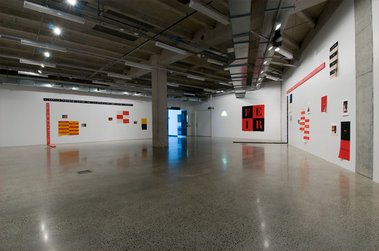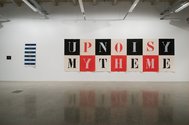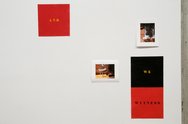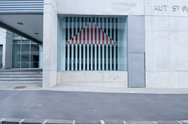John Hurrell – 9 December, 2010
Some artists specialise in language to the degree that they truly reinvent it, but Lewis is not one. He tends to use overkill, bombarding you with words, expressions hurtling down on you from the walls as you circumnavigate the room. Having said that, the show is nicely layered with parallels between the emptying out of the Kondos' apartment and the undermining of western assumptions about Hindu practices like sati.
Auckland
Ruark Lewis with Loma Bridge
In My Empty House
26 November - 23 December 2010
Ruark Lewis and Loma Bridge are two Sydney artists here collaborating at AUT on a show that is a meditation on the activity of one of their friends, Vivienne Kondos, an anthropologist who has written widely on the status of and social constraints on Hindu women in Nepal and India. In My Empty House Kondos and her husband Alex (a sociologist) are the subject of a film and photographs (mainly) by Bridge, particularly their clearing of space in their apartment while they were in the process of selling it and showing it to prospective clients, and the larger shifting of household effects when they later moved to a new location.
Lewis dominates the space they have in Gallery 1, using painted text to comment on Kondos’ ideas. He is a painter interested in the visual dynamics of abstraction and of the act of reading, one who (in this display) works on sections of loose canvas and on planks, not on stretchers or directly on the wall. He likes the use of written expression via the use of stencils (inadvertently linking his practice to Johns and Rivers) to quote aphorisms - in this case sentences from Vivienne Kondos’ essays.
The stencils have serifs which make the lettering look rural (as in wool bales) and a bit hokey - especially in comparison with a very elegant postcard work in sans serif that he has made available. The text works best on the black and red plank paintings that are either horizontal or which drop down the wall vertically to then extend out across the floor. With the words Lewis uses only one cut-out section of each stencilled letter at a time, so that you are left guessing what they might be. The works seem to be about memory loss and so some fragmented sections remain indecipherable; teasers that you enjoy for their peculiar graphic marks and odd stuttering repetitions. Some you can figure out and others remain baffling.
Lewis favours red, orange and yellow bands or squares on which to position his texts, hot earthy colours that seem characteristically Australian (as pigments) and loudly saturated in mood. The writing comments on or reflects Kondos’ thinking, particularly with paintings that say ‘I don’t want to deny women the capacity to act as agents’ or ‘I quote. We witness’. However for me the language doesn’t sparkle (metaphorically speaking), it is dead and academic, and Lewis would be better off making ‘non-objective’ paintings without texts, or writing essays as Kondos has done to elucidate nuances of argument or feeling in depth.
Some artists specialise in language to the degree that they truly reinvent it, (eg Kay Rosen: visual art; Charles Bernstein: poetry) but Lewis is not one. He tends to use overkill, bombarding you with words, expressions hurtling down on you from the walls as you circumnavigate the room. Having said that, the show is nicely layered with parallels between the emptying out of the Kondos’ apartment (‘The image provides a vision of paradise lost’) and the undermining of western assumptions about Hindu practices like sati, the suicide of widows on their husbands’ funeral pyres.
When you examine Kondos’ essays, as Lewis and Bridge obviously want you to do (her book ‘On the Ethos of Hindu Women’ is on sale at the gallery) she is a lively thinker whose positions on various issues can never be second guessed. Even the notion of ‘agency’ which she uses to offset conventional assumptions about sati, she in turn subverts in a separate essay devoted to the philosophical term.
The St. Paul St. installation probably would work better for Lewis and Bridge with families of paintings or photographs placed on the walls together, so ideas gain strength in focussed unison. The material is too scattered to give any sense of a cohesive philosophy that has internally contrasting components. However if you, like the art historian James Elkins, believe that paintings are in fact puzzles that lead to ideas, and that installations might be too, it is a good show to investigate.
John Hurrell
Recent Comments
Roger Boyce
@ vsevolod vlaskine Oh, dear doG, I'd assumed, from your ouroboros-like bit of art-commentary that your persona was fictive and ...
Roger Boyce
Having read the entire exchange between Ruark Lewis and John Hurrell - but having no dog in this fight - ...
John Hurrell
Well art being what it is, it is perhaps inevitable people with opposing views exasperate or infuriate each other. Mental ...




 Advertising in this column
Advertising in this column Two Rooms presents a program of residencies and projects
Two Rooms presents a program of residencies and projects



This Discussion has 8 comments.
Comment
Ruark Lewis, 4:09 a.m. 11 December, 2010 #
Mr. Hurrell is one of those last century art reviewers, whose agency is blurred by what I like to call, adhering to a Cultural Import Substitute Industry status quo.
He's an agent of the academy and suitably dresses like one. From what he writes he wants to remember the paintings (which are banners) as a red/orange/yellow banded scheme characterising something Australian? Does he imply some sun-drenched landscape by this reference? There was blue, and black & white dominated these works. Mr.Hurrell has misapprehended the municipal nature of these signs or simply is colour blind and parochial. There was no use of the colour orange in our designs. This reviewer might improve his insight by taking a short course in visual anthropology. For he has also failed in his account to comprehend other basic evidence when he entered what we have titled IN MY EMPTY HOUSE by mistaking that domain for an apartment dwelling. It was clearly a depiction of a Victorian-period terrace house. He appears to have missed even the most basic evidence laid out in this display in the gallery. He misunderstands the textual forces also. While examining the writings: in the work The Enigma of Sati he credits that text incorrectly and subsequently all the way through his review. The texts are transcriptions. Unfortunately and to his annoyance the display actually speaks. It is a multiplicity of voices. It seems he doesn't like that it has a sound at all. I think he prefers art to be muted, to not have anything to say, except in material codes. His knowledge of art is one of the past and not part of my collectivist thinking.
Absent from his ear was the presence of the sound design by Sydney audio collagist Rik Rue begin_of_the_skype_highlighting end_of_the_skype_highlighting his is a major component of the display and a immersive aspect of the work. Unfortunately the reviewer did not attend the performance on the evening of Nov.25. Such a pity; that work was called EPIGRAMS AND DEFIANT DIALOGUES. At the location I performed vocalisations and 154 spoken epigrams. Each one worthy of being inscribed in stone.
(cont.)
Ruark Lewis, 4:13 a.m. 11 December, 2010 #
I see the paintings as concrete, but also a convenient nomadic skin to lightly carry those particular fragments on. In the performance all the inscriptions were worked out live. Movement was another element of the performance. The performance space and all the elements in the gallery were enacted and not left inert or muted.
I have another term I'm keen on calling The Hierarchy of the Senses. As I read through this review, I found further evidence that Mr. Hurrell is sense deprived. He has avoided the filmic, the sound, and the performative elements of this piece altogether. So his review is incomplete. It really isn't my task here to correct a reviewer's document, but I am. I think that we have entered the age of cross-arts production, where artists work together in creative partnerships. This reflect s a more cosmopolitan and realistic approach. Although the St Paul Street Gallery piece is termed an installation by many, I prefer to think of this as more of a display or a chamber work. I think of it as being a set for performance. That fact that the audience is immersed into a greater sense of the round in such atmospheric and multi-layered environments is important to our collective experience today. This is in contrast to being located in a static fixed position that more conventional visual art is able to deliver. For me the viewer becomes the performer and if the reviewer felt a sense of circumnavigation while in that environment (as he says), then I suspect he's not really owning up to some of the other experiences he had on his particular visit.
Ruark Lewis, 4:17 a.m. 11 December, 2010 #
For the record, I am including section 1 of the performed work, parts of which appear in all the various painted banners visible in the gallery space –
aenigmatēs
1. Like a time bomb
2. Or again and even so
3. The ironies of influence
4. Where even her politics were censored
5. Demanded questions
6. Such signs are pure existence
7. From the past she says
8. To spell agendas
9. Effects a desperate search
10. To captivate the bored
11. And symbolize her questions here
12. These quotes from other lines
13.a Where nothing is achieved by reticence
13.b Except pure existence
14. Where life is haunted by the past
15. I understand the arguments, he says
16. The impossible affects of India
17. Was the desperate struggle from the start
18. A play of feet around agendas
19. Like the adages and homilies applied
20. At a juncture mesmerised
21. From where a film creates a world
22. A story breaks new ground
23. This place of symbols
24. Such notions are complicit
25. Some claims invisible
26. Such hopes unfold
27. A fire is controversial
28. An epic of aesthetics
29. Brings up the question of an exile
30. In a language based on life
31. Will depict a woman
32. And the issue of an armed vagina
33. In a violent protest of denial
34. The strident voice is simple talk
35. The sensational glorified in art
36. It could be said I do not know
37. A lot depends on the ways of telling what I ignore
38. The reflexive nature of the husband beating her
39. How the camera reveals a lie
40.a And fire betrays anxiety
40.b This part I simply must repeat
41. On the one hand he perceived her purity
42. Or the danger of naming that healing pleasure
43. The household niche of comfort
44. The fixity of sentiment and longing
45. That memory works as record
46. This particular part of paradise
47.a In the artifice of gender
47.b Is full of reminders
48. I think I could stop the idea of light
49.a Where the scene is set
49.b A motionless life goes on
50. In a film filled with the piracy of others
John Hurrell, 11:39 a.m. 13 December, 2010 #
Thank you Ruark for your detailed and energetic responses to my review. Of your points, readers more keen-eyed than yourself will have noticed that I did say that your stencilled texts were quotations, for my discussion reveals I was fully aware of how you used Kondos’ writing. I even discussed the possibility of how that usage bridged via a trope to the film and photographic elements, components which despite your indignant protestations to the contrary, I think are a minor part of the show.
The painterly elements dominate, and coincidentally fit in (despite your contrary intentions) with certain other Australian artists in colour properties and visual organisation - like Joseph Watt of the Mornington Island community, for example. If you don't like these associations you should change your images. Your use of stencils helps perpetuate that folky ambience, even if unintended
Although I did not mention it I did notice the sound recording but found it too low in impact to mention. Perhaps the most salient or clearest bits were never played on either of my two visits. And although you do list Rik Rue on the blurb sheet, he is not on the invite as a collaborator in the way that say Loma Bridge is. So much for your condemnation of the ‘Hierarchy of the Senses.’ Your mentioning it now is like belatedly claiming the footnotes are in fact the main discursive body of the essay.
You obviously consider your intended meanings to be self evident, that any performance you present at the opening should be regarded as essential contextualisation for the show’s interpretation. However as a ‘performance set’ in which ‘the viewer becomes performer’, the gallery presents the impression that you intend the visitor's experience to be more open and less determined than what you are now stating is the case. If you wanted to limit it more you should have presented a recording of your performance.
It is not as if I am wildly fanciful or irresponsible in my comments about the show. A large part of what I say is about the Kondos book but even in relation to that your list of decontextualised transcriptions comes across as disparate, woolly and so dull. With no clear connection to Loma Bridge’s film at all.
You seem to imagine the exhibition will be cohesive if Kondos’ book is read. This might be true as the book is a terrific document anyway, but where is the incentive in your exhibition for anyone to bother? It is possible (as I said) with the comparatively restrained visual material on the walls, but not with the cluttered overkill of your aural aphorisms, your calculatedly ‘noisy theme’ – though as I wasn’t present it would be stupid to pre-empt. I would imagine though that the overloaded excess would destroy your power to communicate. Why would anybody be interested?
Ruark Lewis, 2:28 a.m. 15 December, 2010 #
Thank you John, as I suspected - you're a total nutter.
John Hurrell, 8:11 a.m. 15 December, 2010 #
Well art being what it is, it is perhaps inevitable people with opposing views exasperate or infuriate each other. Mental instability? Well, it's not for me to say.
Have a nice Xmas.
Roger Boyce, 2:37 p.m. 16 December, 2010 #
Having read the entire exchange between Ruark Lewis and John Hurrell - but having no dog in this fight - I'd have to say that, to my own unbalanced mind, Lewis sounds more the "nutter" of the two combatants.
I know, I know, I haven't seen the show. It's just that the punctilious and choleric Lewis doesn't really even try to join Hurrell's counter-argument while the long suffering and insufferably polite Hurrell does address (point by point) Mr. Lewis' begging-the-question complaints.
No knockout...but, by points, I'd have to award the match to the 'academically dressed' John Hurrell.
Perhaps Ruark could ask for a rematch.
Roger Boyce, 1:44 p.m. 5 March, 2011 #
@ vsevolod vlaskine
Oh, dear doG, I'd assumed, from your ouroboros-like bit of art-commentary that your persona was fictive and your text parodic.
Google assures me you are real. And, I can only assume (please prove me wrong) that your text is in earnest.
Save us from the alchemically challenged self-eaters who would transmute the gold of visual art into leaden, philosophy-miming, close-order-drill, lines of marching text. Yo left, yo left, yo left, right, left.
"-palimpsestuous-"?
"-deconstructs the spectator-"?
"-multi-modal, metaphoric translation, transcription, double flow, parallel text, modular, aleatoric, and unpredictable -"
Mr. v-v
"Please, please, please, please, -"
- James Brown
tell me you're kidding?
Sincerely
Roger "dominating discourse" Boyce
Participate
Register to Participate.
Sign in
Sign in to an existing account.